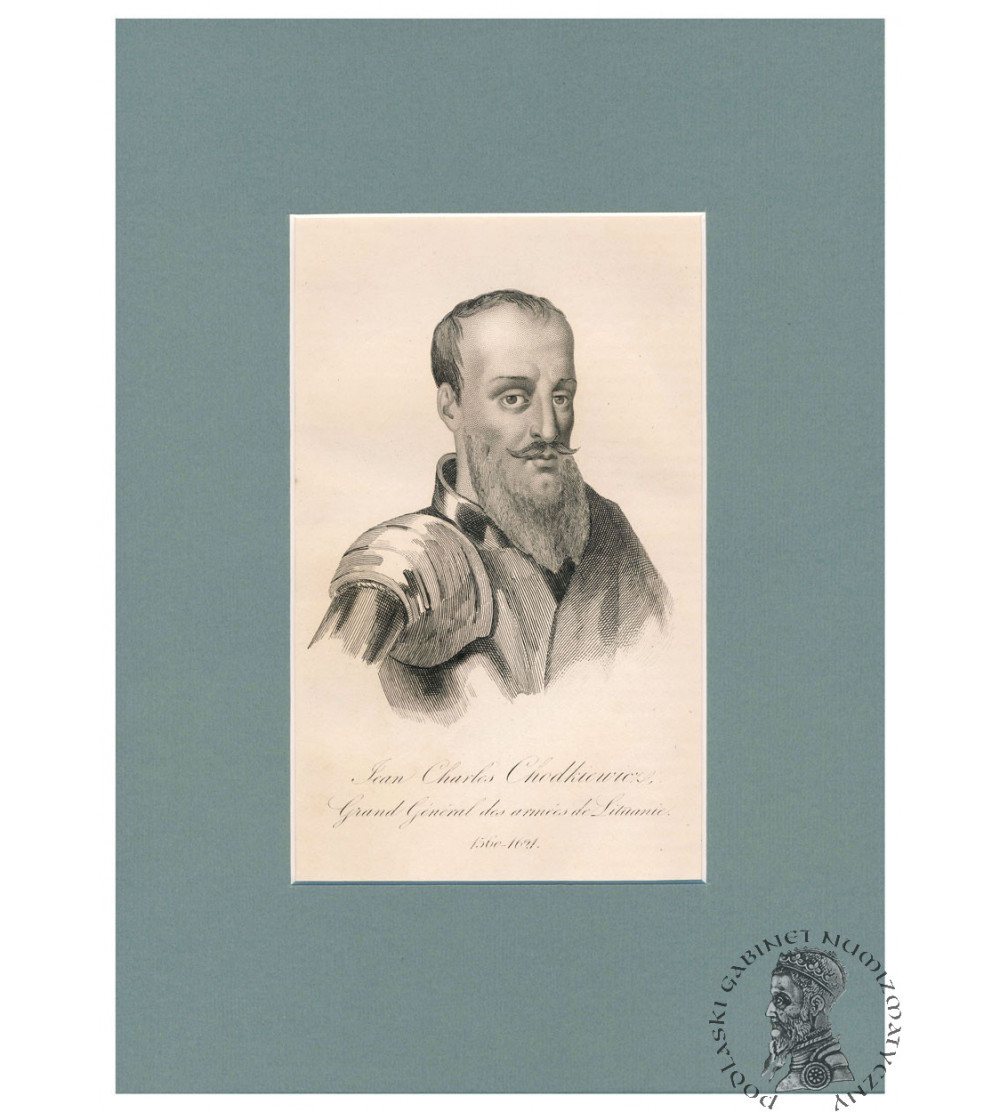




Jean Charles Chodkiewicz, Great Hetman of Lithuania (Grand General of the Lithuanian Army), Jean Charles Chodkiewicz Grand General des armees de Lituanie, portrait, steel engraving 19th century, work from Leonard Chodźko's volume - La Pologne historique, litteraire, monumentale et ilustree, Paris 1839-1841, all A4 format (passe-partout), image dimensions 11 cm x 18 cm, very good condition.
Jan Karol Chodkiewicz (1570/1571-1621) - military commander, field hetman of Lithuania. The year 1560 is usually given as the date of his birth, but Prof. Marian Chadaj has shown that he was born in 1570 or 1571. The son of a magnate, he was fascinated by the military from an early age. He was educated in Italy, where he learned the ways of battle used in Western Europe. After returning to Poland, he continued his education, practicing and fighting under Stanislaw Zolkiewski, Jan Zamoyski and Krzysztof Radziwill. In 1602 he took command of the Republic's forces in Inflants. He quickly gained the respect of his subordinate soldiers. He was known for his extraordinary oratorical skills. He became famous for his victories in battles fought against overwhelming enemy forces. The opponents were afraid of the Polish hussars and were unable to put up effective resistance during the charge, and Chodkiewicz took advantage of this fact, deftly outmaneuvering the enemy troops and gaining a crushing advantage. Hence the spectacular victories, such as the relief at Rakvere Castle (1603), the Battle of White Stone (1604, now Paide in Estonia), and the Battle of Kircholm (1605). The latter ranks among the greatest tactical victories in history. In 1609, Chodkiewicz seized Riga, using ships captured earlier at Parnavė. It was the only battle ever fought by the hetman on water. Soon the conflict in Inflants quieted down, and Khodkevich agreed to move to the eastern front, where he took up arms against troops from Moscow. In 1612 he suffered his first defeat - he failed to reach the Polish garrison in the Kremlin, where he was supposed to deliver food. In 1618 he stormed Moscow - he was unsuccessful, but as a consequence of the fighting the Divlin Truce was signed. The ailing Khodkevich hoped for a rest from eternal militancy, but soon had to return to the front to defend the country against the invading army of Sultan Osman II. The Poles took up positions in camp near Chocim in 1621. The Hetman managed to fend off the Turkish onslaught, but did not live to see the signing of the peace treaty - on September 23 he handed over the mace to regimental officer Stanislaw Lubomirski, uttered the words In manus tuas Domine (In your hands, Lord) and died. Source: ciekawostkihistoryczne.pl
CHODŹKO, Leonard Borejko (1800-1871), La Pologne historique, litteraire et monumentale, (...), 1835-1842. A monumental work by the famous Polish émigré publisher Leonard Chodźko which is a history and geographic-political description of Poland. The work was published in three volumes. The first part is the history of Poland from the earliest times to the reign of Wladyslaw Lokietek. The second volume covers the history of Poland from the reign of Casimir the Great to the death of Stefan Batory, while the last volume covers the history of Poland from the beginning of the reign of Sigismund III Vasa until the events contemporary to the Author and the Readers, i.e. the November Uprising. Each part also contains descriptions of unique and interesting places in Poland, as well as basic information about literature, art and science. In addition, the work contains examples of exceptional monuments in the Polish lands. An important part of the work includes fairy tales, legends and short stories, as well as an essay on dramatic theater in Poland. The work also contains a description of Polish dances, such as the polonaise, mazurka, and krakowiak. The work is very richly illustrated, with numerous intaglios, natural monuments, sacred objects, castles, palaces, cities, portraits of important historical figures from the history of Poland, works of art, notes of songs, etc. This brings the total to 180 engravings (including maps), in a set of three volumes, i.e. 60 engravings for each volume collated with a table at the beginning of the volume.